I left early in the morning and managed to catch an earlier train. A trio climbed aboard the train and sat on the other side of the aisle to me; a girl in her preteens, a boy in his teens, and their mother. The mother was rather rotund, possessed a deep almost masculine voice, and shouted everything at 80dB. I had visions of her in bed with her husband, she whispering sweet nothings to him, he wearing ear plugs and head buried under a pillow. I digress. The children spoke Dutch, she spoke a weird Dutch interspersed with what seemed like an Eastern European twang at times. Half the time she was distracted by her phone. Sometimes the girl asked her to speak more quietly, but mum had earphones rammed in her ears, so probably never heard the request.
I arrived at my destination, and at the station took time out to answer a message from my eldest daughter. She lives in London with partner George, and 12 month old Ralph. "Dad, we are moving on 15th to 17th July, and we will be staying at Max's (George's brother) for a while to save some money to build up funds for a house. George and his family will move some of our stuff to Max's, and put the rest in storage. Can Ralph and I come and stay at yours during the move, please?"
"Certainly," I replied, "but I may not be back by then. But by all means use my house as a base." She was pleased with that response.
I walked up to the Wilhelminaplein, passing by parts of the BOSK "living forest" on the way. The market today was a quarter the size of yesterday, with the freed up space being mopped up by more tables from the surrounding cafes and restaurants. Today's market focussed on arts and crafts.
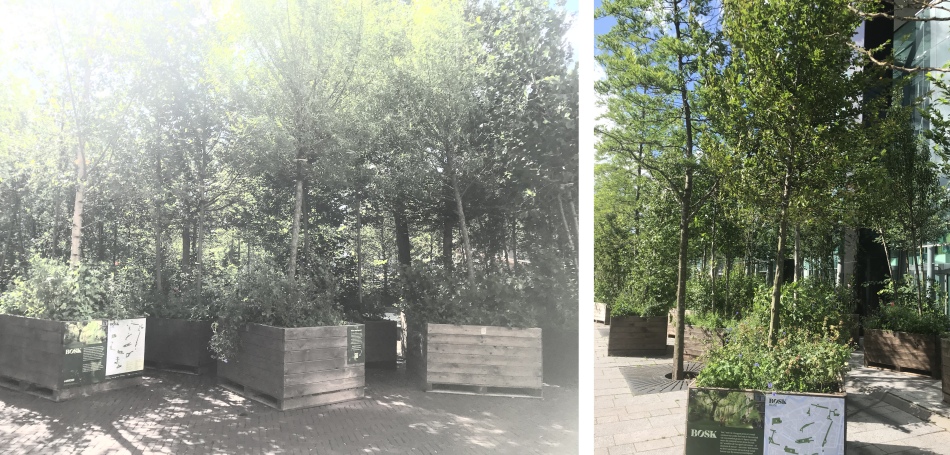 Examples of the BOSK "Living Forest", Complete with Bird Sounds Emanating |
"Who is the artist?" I asked. The man was; he painted in water colour only. He had tried acrylics once, but could not achieve the colours he wanted. He also had an interest in boats, hence the boats and ships in his paintings.
At another stall I got chatting with a chap who was standing behind displays of square paintings, each with poetry on them. He explained that he and his two colleagues, the female one being the artist, put a lot of their material on Instagram, hence the square format. All three of them wrote poetry, but his poems also included more darker elements to them such as death. Despite their Instagram outlet, he took pains to explain to me that he gained much pleasure from being on the stall at the market. "I get to meet lots of different people, we share stories and we get instant feedback from the public about our works," he informed me. Sadly I could not understand much of their poetry which was entirely in Dutch. I thanked the man for sharing time with me, and wished them well with their venture.
By now, the Fries Museum, the whole reason for my being here. I really enjoy visiting this place, it always seems so fresh and new each time. They have over 200,000 items, but can only display 1000 at a time, with two exhibitions in parallel. The museum has a policy of periodically changing over the displays so that items are not hidden away from public view in storage for decades. In addition, they loan items to other museums across the country, and in some cases donate items to other museums, enhancing their policy of making items available to the public instead of keeping then in storage.
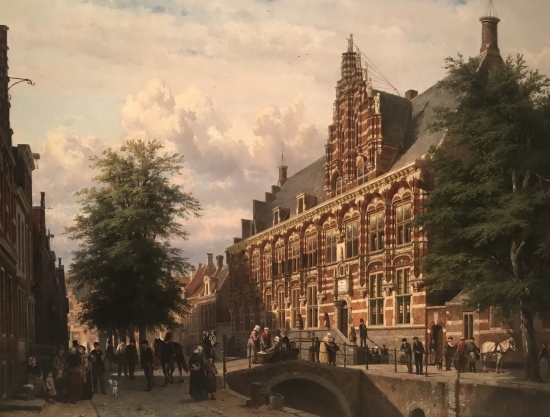 Cornelis Springer painting of the Chancellery - Kanselarij |
For an explanation of this attitude we need to go back to the 15th century, when the Schieringen (country people) and the Vetkopers (townspeople) were fighting one another by fire and sword - for obvious reasons. Eventually the Vetkopers prevailed, but the mutual animosity remained. Between 1566 - 1571 the capital's authority over the province was consolidated by the construction of the Chancellery on the Turfmarkt. The impressive government building housed the Hof van Friesland (High Court of Friesland) which governed Friesland and also served as the province's highest court of justice. This attracted many lawyers and government officials who came to live in the Turfmarkt area, which considerably added to its prestige.
At the time the Amsterdam artist Cornelis Springer (1817 - 1891) painted the Chancellery - Kanselarij, the building no longer served as the residence of the powers that be, but it had become a prison. Yet, the area was still inhabited by many distinguished citizens, including politicians and lawyers. Through the centuries, the building served many purposes, including that of a hospital, a barracks, an archive and a museum.
In 2012 the Fries Museum moved out and resettled at its new location in Wilhelminaplein.
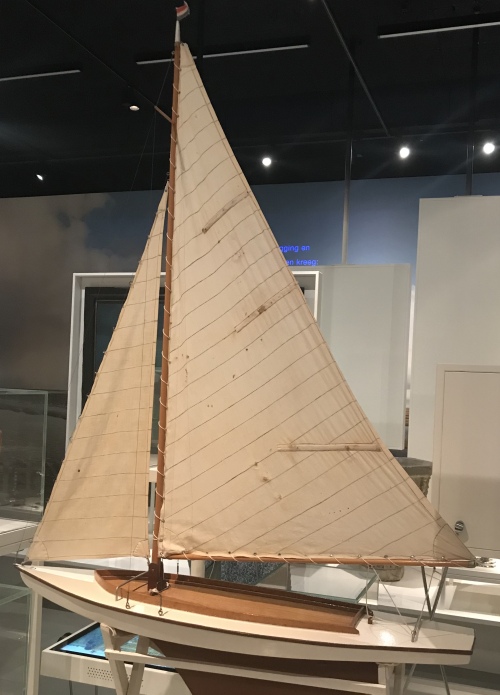 Scale Model of a Bulthuis BM |
"During the reports and queries, Mr Bulthuis brings up that he has designed a small sailing boat, which can be built by any amateur and which is within most people's financial reach, even for those of modest means, as the costs, sails etc. included, amount to no more than around one hundred guilders."
The above lines are from the minutes of the general meeting of the Bergumer Lake Watersports Association of 22nd June 1928. Hendrik Bulthuis (1892 - 1948) was a barber in the village of Burgum and an enthusiastic member of the local watersports association. Not only was he a keen yachtsman, he was also a fervent do-it-yourselfer who spent many hours on drawing boat designs and making scale models, dreaming of designing a sailboat everybody could build and afford. His first successful design was the BM (from Bergumer Meer), a simple sailboat that cost less than one hundred guilders to build: 40 for the wood, including mast and boom, 15 for the hardware and 28 for the sails (main and foresail). After the publication of an article about it in the aquatic sports magazine "Waterkampioen" there was a real run on the small barber's shop in Bergum. However, people did not come for a shave or a haircut, but for a set of drawings or they needed the sailing barber's advice on problems they had encountered building their own boats. In the meantime, Bulthuis was working on a new plan for an affordable family sailing boat. He came up with the "Zestienwadraat" or "16m squared", named after then surface of the boat's sails, which totalled sixteen square metres. It became the most successful small open sailing boat in the Netherlands' history of aquatic sports. It is estimated that a total number of 11,000 BMs and 16M squared were built, either in professional shipyards or in sheds in people's backyards. Bulthuis' sailboats dominated the Frisian lakes for a considerable time. Although he barely managed to earn a living as barber, Bulthuis invested most of the proceeds of his business in his hobby, the sailing club. When he fell seriously ill, his sailing friends erected a fund to supports Bulthuis and his family during the remaining months of his life.
One of the many topics covered in the museum was the terp, which took my interest. Friesland is terp country. These residential hills protected early Frisians from the unpredictable sea for centuries. The first terps date back to 600BC. Until AD 1000 the terp residents continued making the mounds higher and wider. Meanwhile, many objects ended up in the soil, and were well preserved in the mounds. In fact, the terps are actually Friesland's treasure chambers.
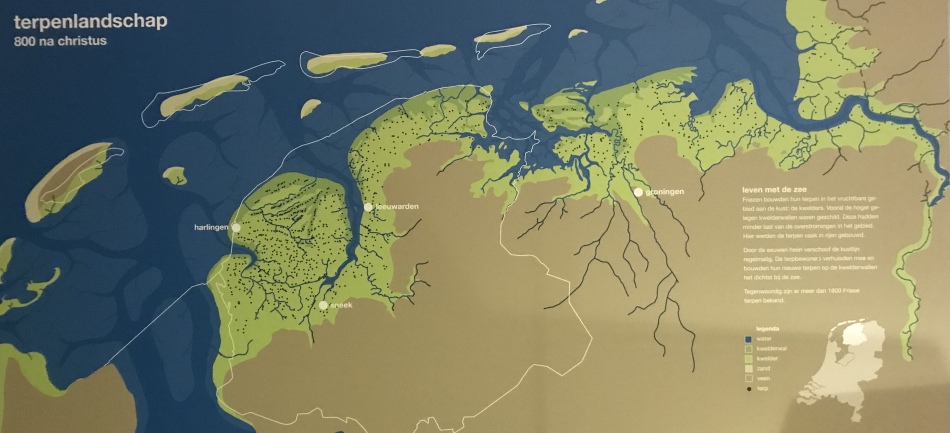 Terps Map (the Terps are Marked by Black Dots) |
The last time I visited the museum, the famous Hindeloopen Room was being refurbished. Thankfully it was now on display again in all its glory. The story behind this room is as follows.
The quirky town of Hindeloopen used to be a truly global city. In the 17th and 18th centuries the Hindeloopen sailors conducted extensive trade through Amsterdam with the countries around the Baltic Sea. At home their wives surrounded themselves with exotic luxuries. They combined colourful fabrics from India, China, Scandinavia and Amsterdam with gay abandon.
The best rooms in the captains' houses were decorated from floor to ceiling with Chinese porcelain, Indian fabrics with ornate floral motifs, Dutch furniture and wooden souvenirs from the Baltic region. But when trade collapsed at the end of the 18th century, outside influences ceased. The best rooms remained as they were and came to be known as "Typically Hindeloopen".
These wonderful rooms were discovered by an international audience in the late 19th century. A mobile Hindeloopen Room caused a sensation at the 1878 World Exhibition in Paris. It was the first stop in an international tour. Suddenly Hindeloopen itself had become an export product.
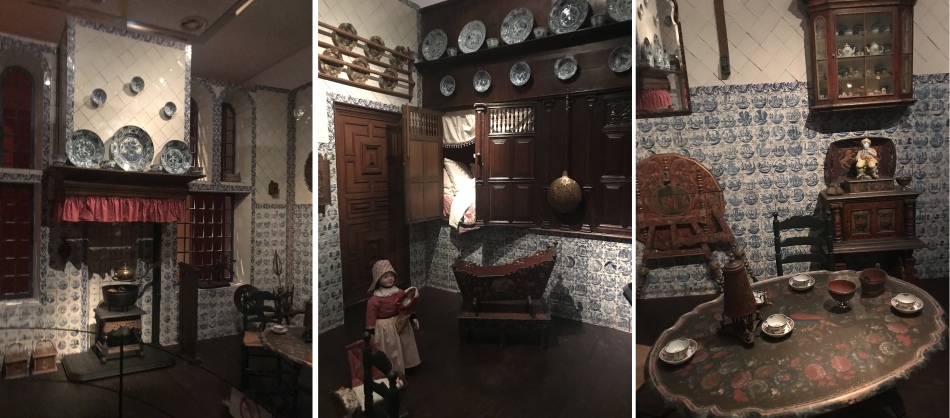 Hindeloopen Room |
It was during his stay in Morocco that he began to take a deep interest in all manner of engines. The Mercedes-240 is mostly used as a taxi in Morocco, where its German origin and reputation for quality and indestructibility have made the vehicle a status symbol. The Moroccan's ability to cannibalise old taxis in order to keep existing ones going fascinated him. Indeed it is said that some taxis have done several million miles due to such recycling of engine parts. Van Hove built his Dorigin entirely from Mercedes-240 parts and drove it to its country of origin, where the car is seen more as Moroccan than as a typical German product. In this way, the work of art poses questions about identity and ownership.
For the artist, the engine symbolises industrialisation, which in many countries marked the end of traditional craftsmanship. Production line work has replaced handcrafts. With his impressive replicas, Van Hove puts traditional crafts back on the map. He combines the beauty of design with current themes such as the distribution of wealth and the disparities between the West and the rest of the world.
Glossy wood, shiny copper, polished mother of pearl: materials from all over the world are combined in the traditionally reproduced engines of Éric Van Hove. From the smallest screw to the cylinder head: international craftsmen handcraft each part under the direction of Van Hove.
The highlight of the exhibition is the D9T, a reproduction of a Caterpillar D9 bulldozer engine. Initially this vehicle was designed for construction projects in developing countries. Since the Vietnam War, this bulldozer has often been used by regimes to suppress uprisings and riots and as barricades. Because of this, the bulldozer has come to symbolise oppression instead of construction. Van Hove's reproduction consists of 295 parts, made from 46 materials by 41 different craftsmen. The artwork consists of engraved cedar wood from the Atlas Mountains, carved purpleheart wood from Brazil, wenge wood from Congo and tatajuba wood from Suriname, as well as materials such as polished mother of pearl, bones, ceramics, marble, copper and tin.
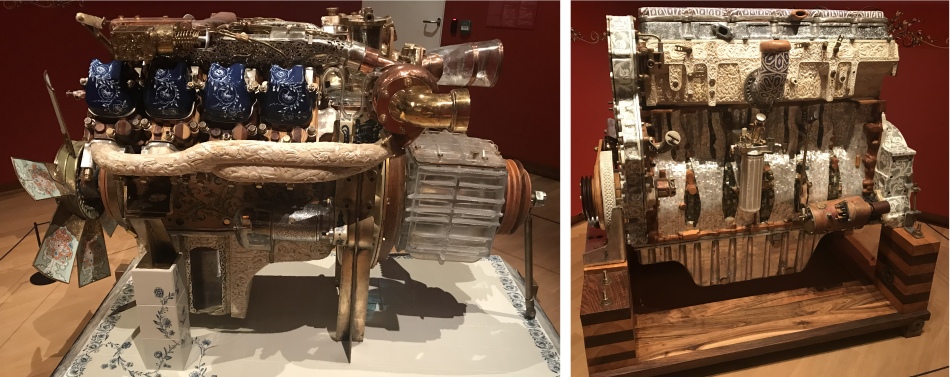 Éric Van Hove Exhibition |
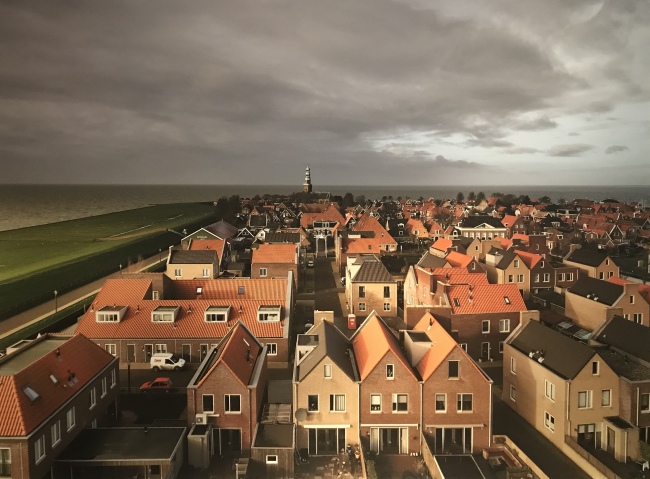 Hindeloopen by Hans Wilschut |
In the 17th century and especially in the 18th century, draughtsmen walked through Friesland and made drawings of views of towns, villages, streets and important buildings. The urban landscape was captured in this way until the invention of photography. Thanks to these drawings and paintings, we can now clearly see how the cities grew over time.
The Museum of Friesland's commissioning of photographer Hans Wilschut to portray the towns of Friesland revisits this tradition. Wilschut photographs are a contemporary look at the thirteen Frisian cities of today. And he offers an unusual perspective; literally, because many of his photograph are taken from a higher elevation, and figuratively because that viewpoint he can pay particular attention to places of transformation. It is not the eye-catchers of the city that he photographs, but rather the places where the changes to the city can be seen.
Another exciting exhibition was titled "A la Campagne: French Light from Maris to Monet". Thanks to the Museum Boijmans Van Beuningen, the most beautiful landscapes by French, Dutch and Belgian artists were being exhibited together in Leeuwarden for the first time. They portrayed nature and light in an irresistible way.
Equiped with tubes of paint and portable easels, French artists headed for the forests of Barbizon. Following in their footsteps, their Dutch counterparts also sought inspiration outdoors. Light became increasingly important in depiction of French and Dutch landscapes. Impressionists such as Monet transformed transformed their pictures into a haze of colourful dots and specks, rich in shadows and full of light. Dutch colleagues came to paint in the French light as well. Around the same time, they also discovered their own Barbizon in picturesque Oosterbeck. Treasures by Cezanne, Monet, Pissarro, Gaugin, Maris, Van Gogh, Sisley, Boudin, Weissenbruch and others served as guides through the artistic development of the "French View" of the landscape - from the Barbizon School to post-impressionism.
Other exhibitions included "You Used to Fly, Go Everywhere and Wake up Those who are Asleep by Petrit Halilaj; featured installations, drawings and videos exploring themes of cultural identity, nationality and heritage. Finally an exhibition titled "Then Came the Wolves" by Mai Van Oers shared her inner world. It was totally lost on me.
Suitably saturated with Frisian culture again, I left the museum and headed out into one of the city's shopping streets where I purchased some gifts for my grandchildren. Mission accomplished, All I had left to do now was enjoy a coffee in Wilhelminaplein, and catch a train back to Harlingen.
